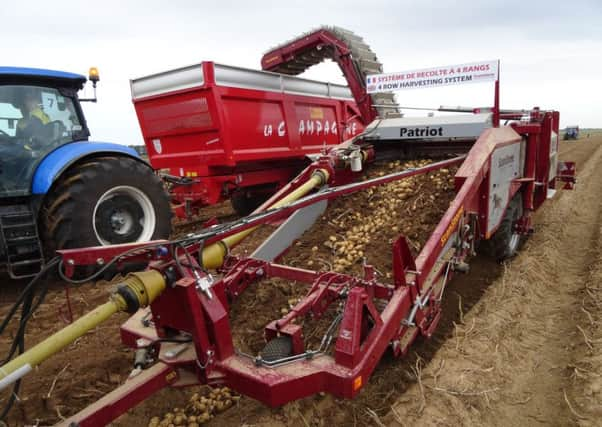Potato growers continue to learn that '˜less is more'


The message being given at the AHDB’s Strategic Potato open day at Meigle in Perthshire on fertiliser follows on from revelations earlier in the year from the project that by reducing tillage depth and doing away with the “recreational pastime” of bed tillage, growers could save costs and increase overall yields and the weight of the crop which packed out.
• READ MORE: Farming news
Dr Mark Stalham from the National Institute of Agricultural Botany said that by reducing the amount of later nitrogen applied to the crop the plants were less likely to put so much into growing green foliage later into the season, allowing the crop to senesce naturally.
Advertisement
Hide AdAdvertisement
Hide Ad“While its common practice, giving the crop that extra nitrogen means it tends to carry on just too late into the season – and as far as the potato crop is concerned we’re not out to grow haulm,” he said.
Stalham said that less nitrogen also let the crop reach the later stages in its physiological development – meaning skin set and other storage factors also stood to benefit from lower N rates.
“And while there is always a risk that by reducing nitrogen rates the crop might yellow off too early and not reach its full yield potential, out of 77 site trials we have only found this to be the case in two of the trials.
“So while the application of additional nitrogen might be viewed as an insurance policy – when it’s only likely to pay out less than one year in ten the savings and additional yields offered by cutting back on the nitrogen applications look to be a worthwhile gamble.”
Stalham said that the SPot project was all about giving growers the confidence to take on board these ideas which offered the opportunity to save costs and increase output – while not representing any serious risk of crop losses.
Work currently underway to help grower reduce the costs of blight control – one of the most expensive areas of growing the crop – through better prediction methods based on the prevalence and development potential of the disease was also aimed at allowing potato growers to reduce their costs.
Advertisement
Hide AdAdvertisement
Hide AdWith weekly sprays meaning ten or 12 applications of different chemicals were often made in a year to keep the disease out of the crop while not encouraging the build-up of resistant forms of blight, Alison Lees of the James Hutton Institute said that the Hutton Criteria for predicting blight outbreaks was one useful tool for growers to use while spore traps – which picked up the infective agents before they were visible on the crop – could further refine this.